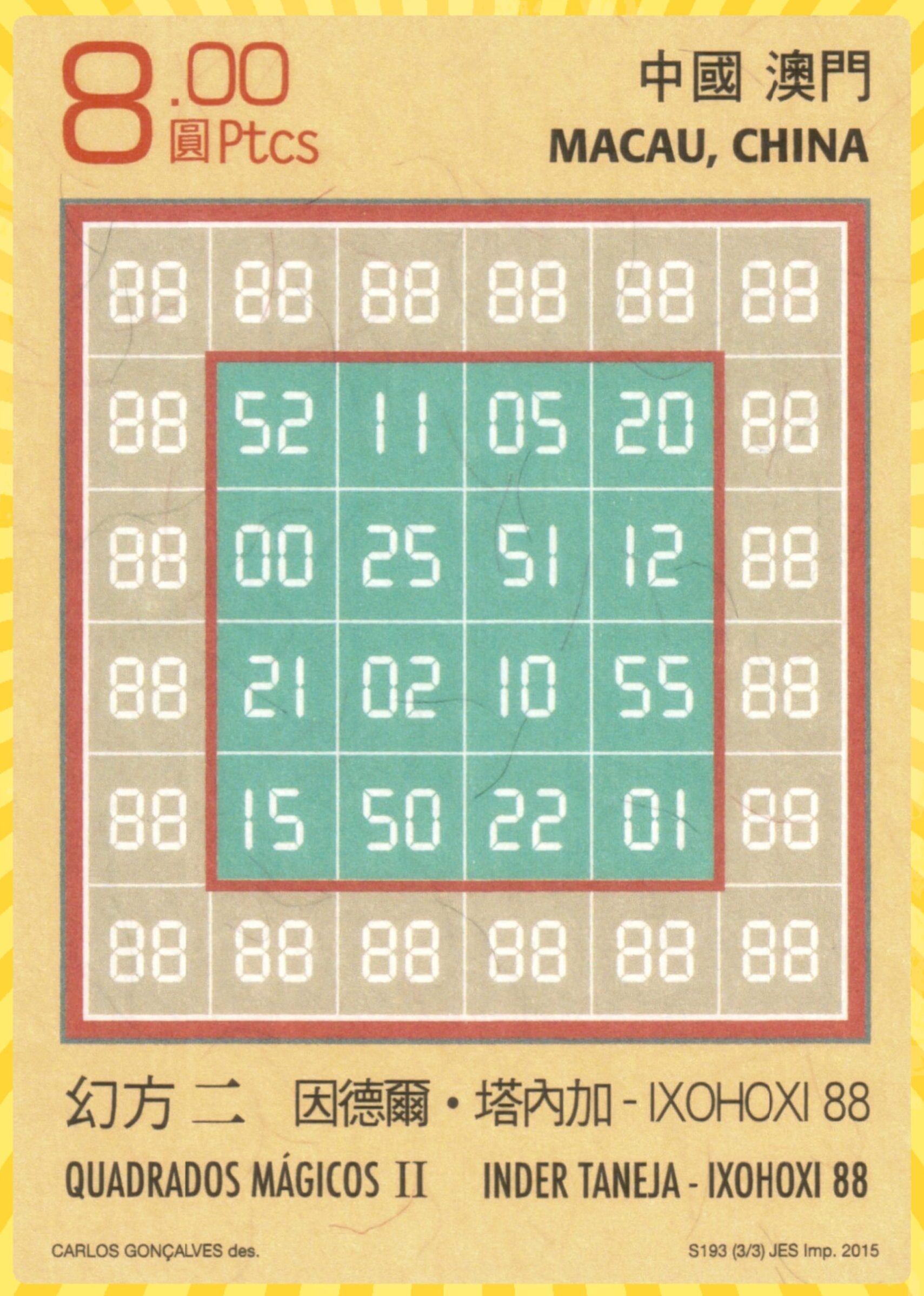There are many ways of representing magic squares with palindromic type entries. Also, we can write magic squares in the composite forms based on pair of Latin squares. This paper works with magic squares of order 3 to 6. By upside-down, we understand than by making 180o it remains same. When the magic square is of both type, i.e., upside-down and mirror looking, we call it an universal magic square. By mirror looking we understand that putting in front of mirror, still we see the image as a magic square. In case of mirror looking, writing as digitais fonts, 2 becoms 5 and 5 as 2. In case of upside-down, 6 becomes 9 and 9 as 6.
The magic squares of order 9, we have considered in two different situations. One as bimagic and another as pandiagonal. In case of order 8, we considered the situations with pandiagonal and bimagic. For complete work for the orders 3 to 25, the readers can access the links given in the references at the end. This work can be accessed online at the following link:
- Inder J. Taneja, Universal and Upside-Down Magic Squares of Orders 7 to 10, Zenodo, November 05, 2024, pp. 1-120, https://doi.org/10.5281/zenodo.14041164
Magic Squares of Order 7
a) 2-Digits Cell Entries
Example 1. The Digits (0,1,2,5,6,8,9)
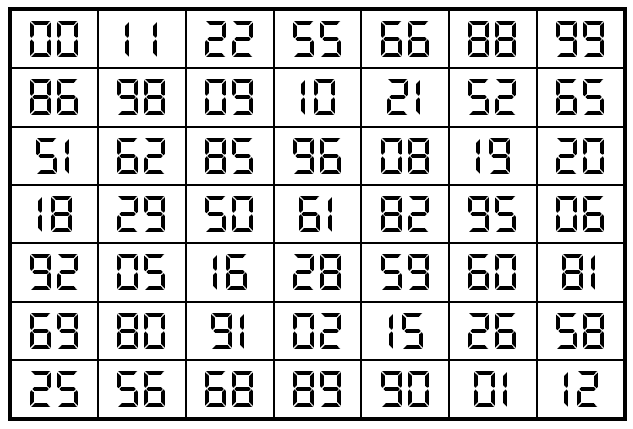
It is pandiagonal upside-down magic square with magic sum S7×7(0,1,2,5,6,8, 9):=341.
b) 3-Digits Cell Entries
Example 2. The Digits (0,1,2,5,6,8,9)
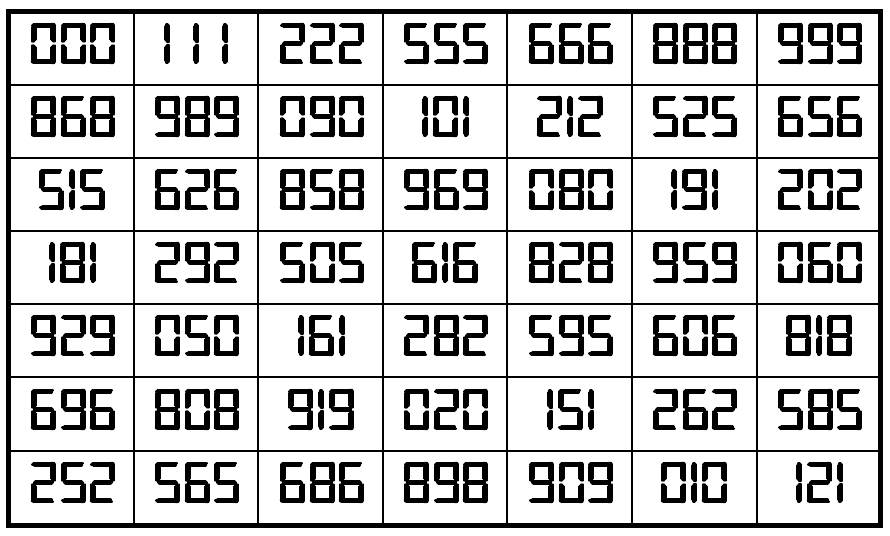
It is pandiagonal upside-down magic square with magic sum S7×7(0,1,2,5,6,8, 9):=3441. In this case, the entries are palindromes.
c) 4-Digits Cell Entries
Example 3. The Digits (1,6,9)

It is pandiagonal upside-down magic square with magic sum S7×7(1,6,9):=36663.
Example 4. The Digits (2,5,8)

It is pandiagonal universal magic square with magic sum S7×7(2,5,8):=42218.
c) 6-Digits Cell Entries
Example 5. The Digits (1,8)
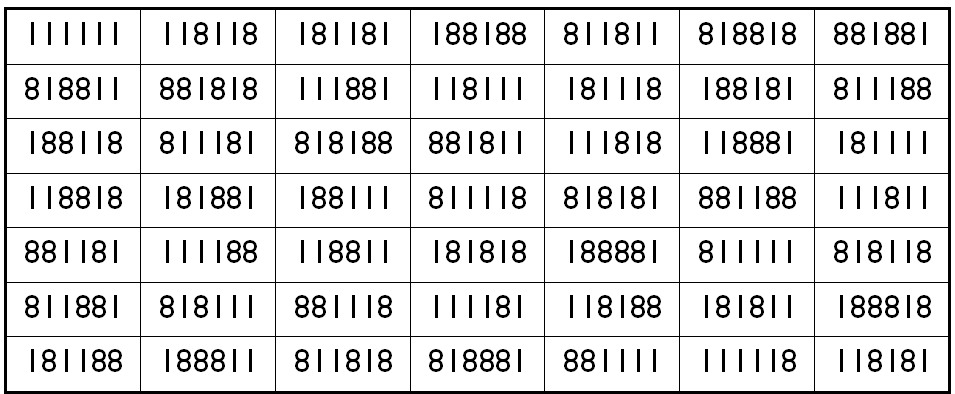
It is pandiagonal universal magic square of order 7 for 2-digits (1,8) with magic sum S7×7(1,8):=3111108.
Example 6. The Digits (2,5)
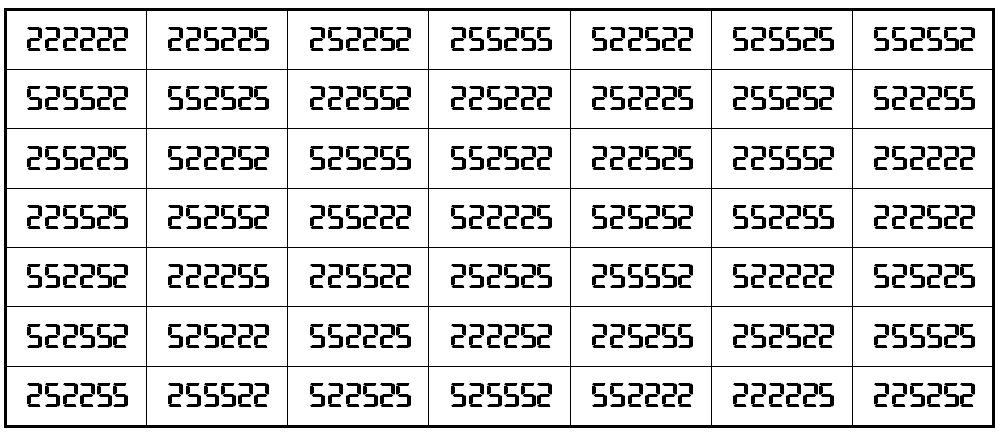
It is pandiagonal universal magic square of order 7 for 2-digits (2,5) with magic sum S7×7(2,5):=2555553. For the mirror looking version, the sum is different S7×7(2,5):=2888886.
Example 7. The Digits (6,9)
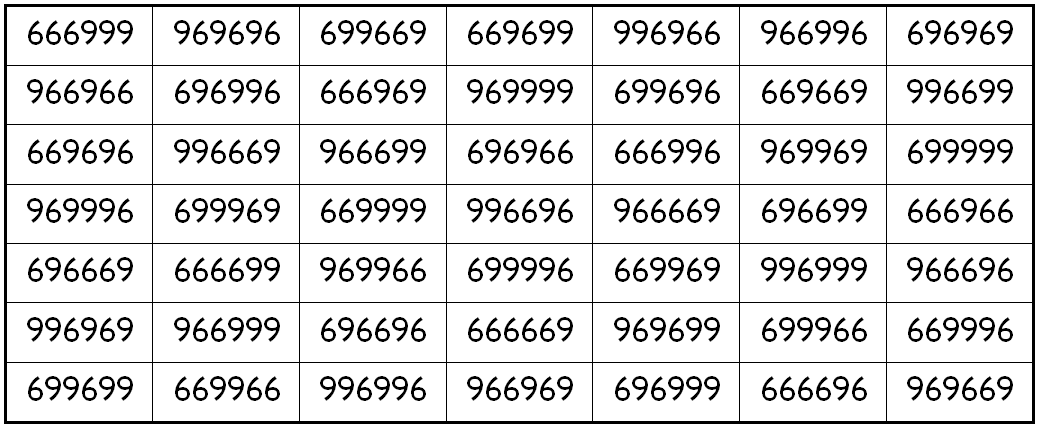
It is pandiagonal upside-down magic square of order 7 for 2-digits (1,8) with magic sum S7×7(6,9):=5666994.
Magic Squares of Order 8
a) 4-Digits Cell Entries
Example 8. The Digits (1,6,9)
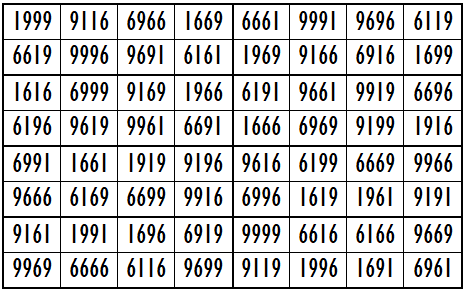
It is upside-down magic square with magic sum S8×8(1,6,9):=52217.
Example 9. The Digits (2,5,8)
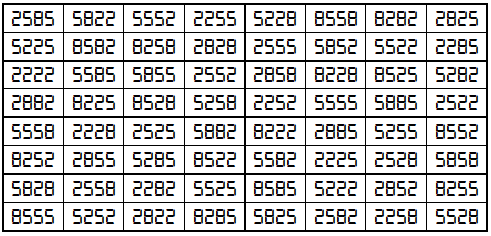
It is universal magic square with magic sum S8×8(2,5,8):=41107.
b) 5-Digits Cell Entries
Example 10. The Digits (2,5,6,9)

It is pandiagonal universal semi-bimagic square with magic sums S8×8(2,5,6,9):=488884 and Sb8×8(2,5,6,9):=34928450732.
Example 11. The Digits (0,2,5,8)

It is universal semi-magic square with semi-magic sum S8×8(0,2,5,8):=333330.
c) 6-Digits Cell Entries:
Example 12. The Digits (1,8): Pandiagonal
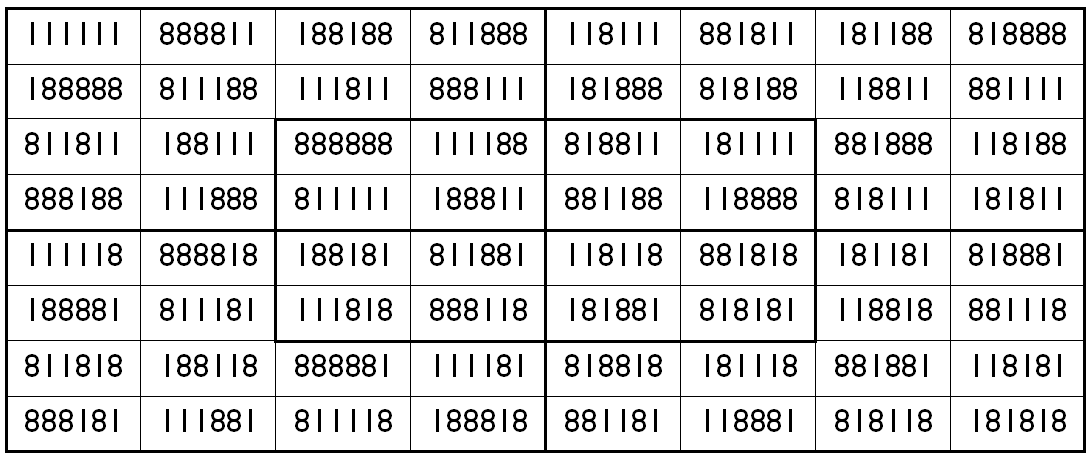
It is pandiagonal universal magic square of order 8 with magic sum S8×8(1,8):=3999996. The blocks of order 4 are also pandiagonal with equal magic sums S4×4(1,8):=1999998.
Example 13. The Digits (1,8): Pandiagonal and Bimagic
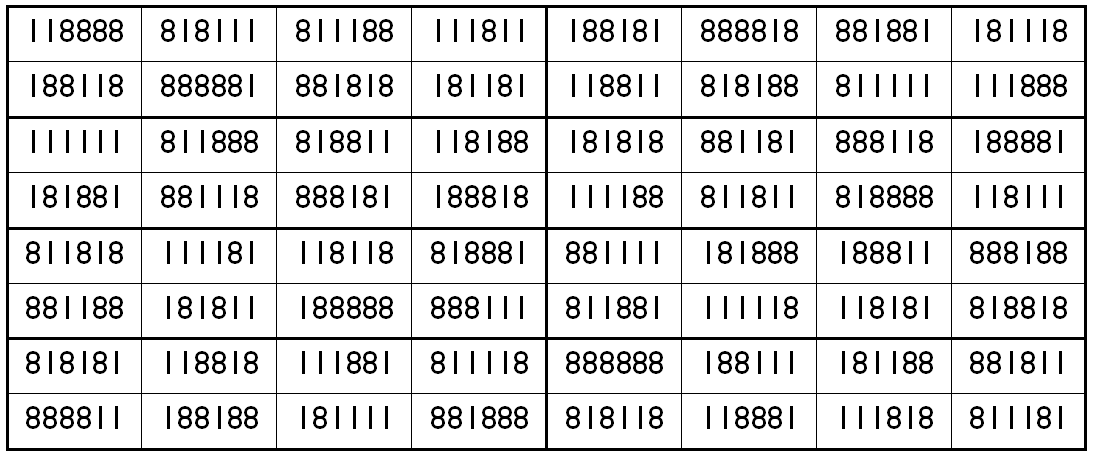
It is universal pandiagonal bimagic square of order 8 with magic sums S8×8(1,8):=3999996 and Sb8×8(1,8):=2989894989900.
Example 14. The Digits (2,5): Pandiagonal

It is pandiagonal universal magic square of order 8 with magic sum S8×8(2,5):=3999996. The blocks of order 4 are also pandiagonal with equal magic sums S4×4(2,5):=1555554.
Example 15. The Digits (2,5): Pandiagonal and Bimagic

It is universal pandiagonal bimagic square of order 8 with magic sums S8×8(2,5):=3999996 and Sb8×8(2,5):=1391692305276
Example 16. The Digits (6,9): Pandiagonal

It is pandiagonal universal magic square of order 8 with magic sum S8×8(6,9):=6666660. The blocks of order 4 are also pandiagonal with equal magic sums S4×4(6,9):=3333330.
Example 17. The Digits (6,9): Pandiagonal and Bimagic

It is upside-down pandiagonal bimagic square of order 8 with magic sums S8×8(6,9):=6666660 and Sb8×8(6,9):=5737362626268.
b) 11-Digits Cell Entries
Example 18. The Digits (1,8)

It is pandiagonal universal bimagic magic square with magic sums S8×8(1,8):=399999999996 and Sb8×8(6,9):=29898989908389898989900.
Example 19. The Digits (2,5)

It is pandiagonal universal bimagic magic square with magic sums S8×8(2,5):=311111111108 and Sb8×8(6,9):=13916947251838608305276.
Example 20. The Digits (6,9)

It is pandiagonal upside-down bimagic magic square with magic sums S8×8(6,9):=666666666660 and Sb8×8(6,9):=57373737374426262626268.
Bimagic Squares of Order 9
a) 4-Digits Cell Entries
Example 21. The Digits (1,6,9)
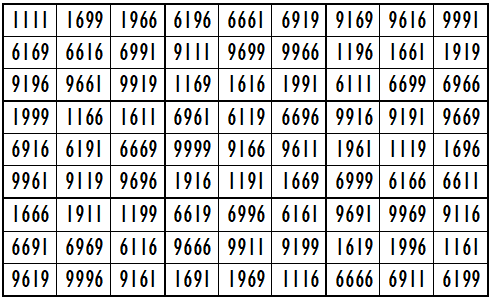
It is upside-down bimagic magic square with magic sums S9×9(1,6,9):=53328 and Sb9×9(1,6,9):=414976074.
Example 22. The Digits (2,5,8)
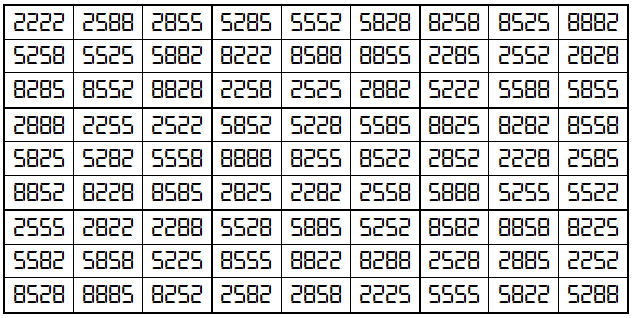
It is universal bimagic magic square with magic sums S9×9(2,5,8):=49995 and Sb9×9(2,5,8):=332267679.
b) 7-Digits Cell Entries
Example 23. The Digits (1,6,9)
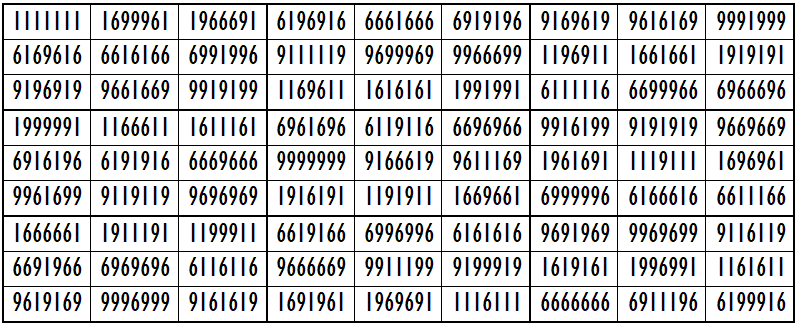
It is upside-down bimagic square of order 9 with 3-digits (1,6,9). The magic and bimagic sums are given by S9×9(1,6,9):=53333328 and Sb9×9(1,6,9):=415039806496074 respectively.
Example 24. The Digits (2,5,8)

It is universal bimagic square of order 9 with 3-digits (2,5,8). The magic and bimagic sums are given by S9×9(2,5,8):=49999995 and Sb9×9(1,6,9):=332323500767679 respectively.
c) 8-Digits Cell Entries
Example 25. The Digits (1,8): Bimagic

It is universal bimagic square with magic sums:
S9×9(1,8):=333333330 and S9×9(1,8):=333333330:=21264570654621018.
Moreover, the sums of nine entries in each blocks of order 3 are the same as of magic square.
Example 26. The Digits (2,5): Bimagic
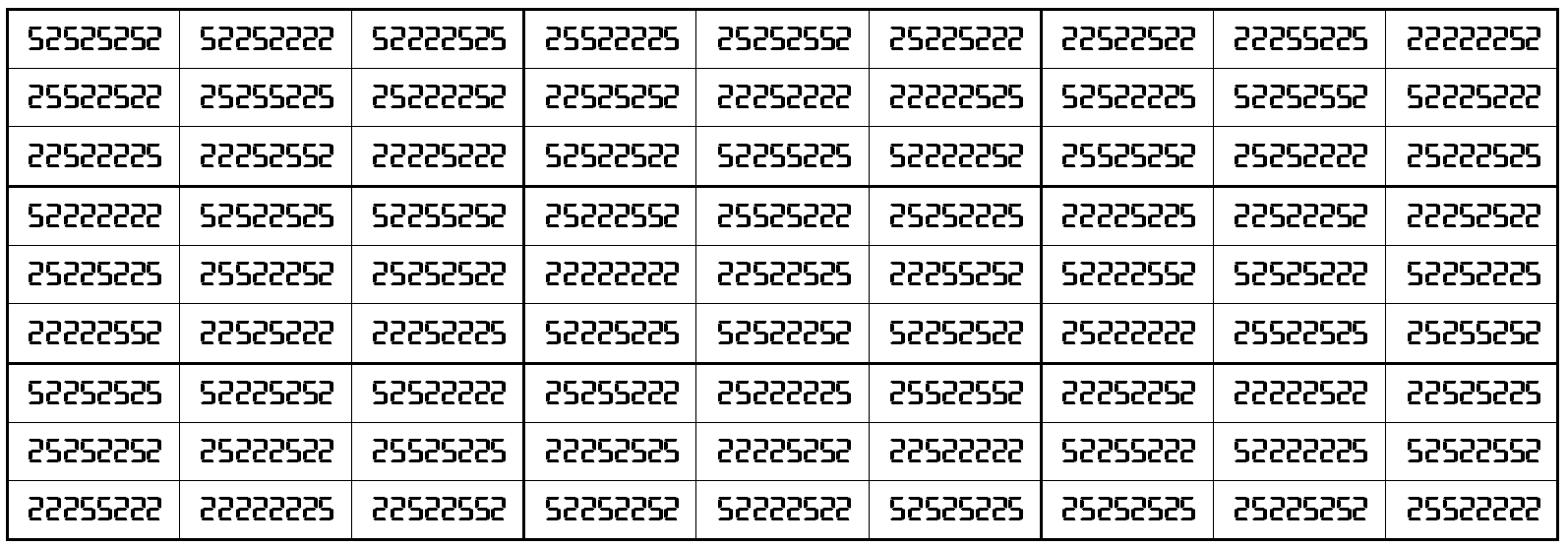
It is universal bimagic square with magic and bimagic sums given by
S9×9(2,5):=299999997 and Sb9×9(2,5):=11638163616381639.
In the mirror looking case the magic and bimagic sums are given by
S9×9(2,5):=399999996 and Sb9×9(2,5):=19415941238603862.
The sum of 9 members of each block of order 3 are the same as of magic square.
Example 27. The Digits (6,9): Bimagic

It is universal bimagic square with magic sums:
S9×9(6,9):=700009992 and S9×9(6,9):=333333330:=56084162583030534.
Moreover, the sums of nine entries in each blocks of order 3 are the same as of magic square.
Pandiagonal magic Squares of Order 9
a) 4-Digits Cell Entries
Example 28. The Digits (6,8,9)
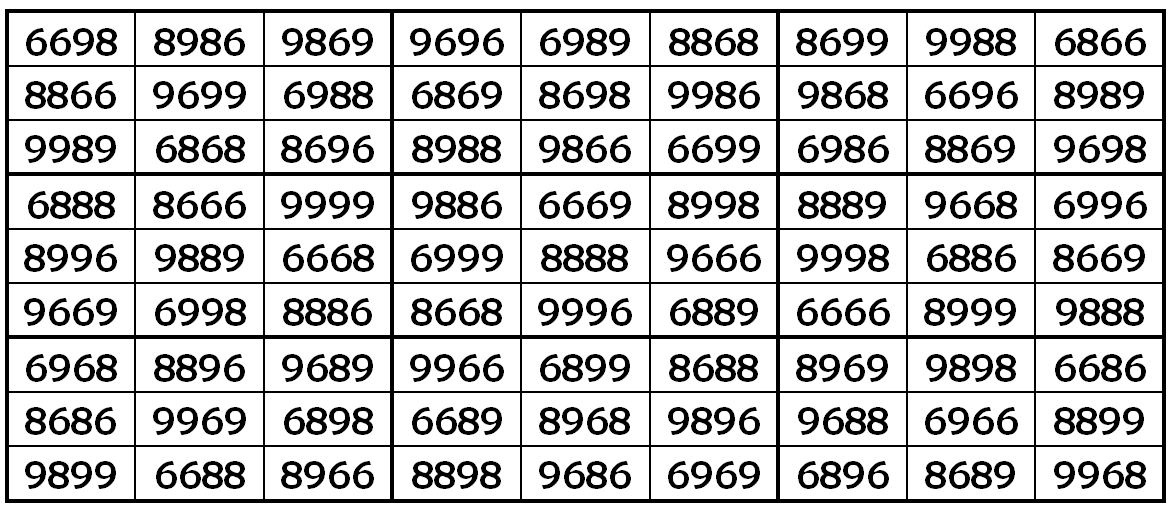
It is upside-down pandiagonal magic square of order 9 with 3-digits (6,8,9). The magic sum is given by S9×9(6,8,9):=76659.
Example 29. The Digits (0,2,5)
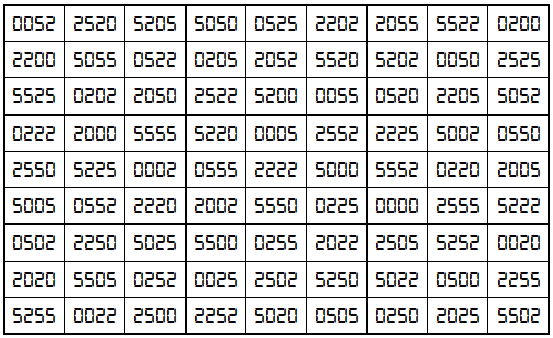
It is pandiagonal universal magic square of order 9 with 3-digits (0,2,5). The magic sum is given by S9×9(0,2,5):=23331.
b) 7-Digits Cell Entries
Example 30. The Digits (6,8,9)
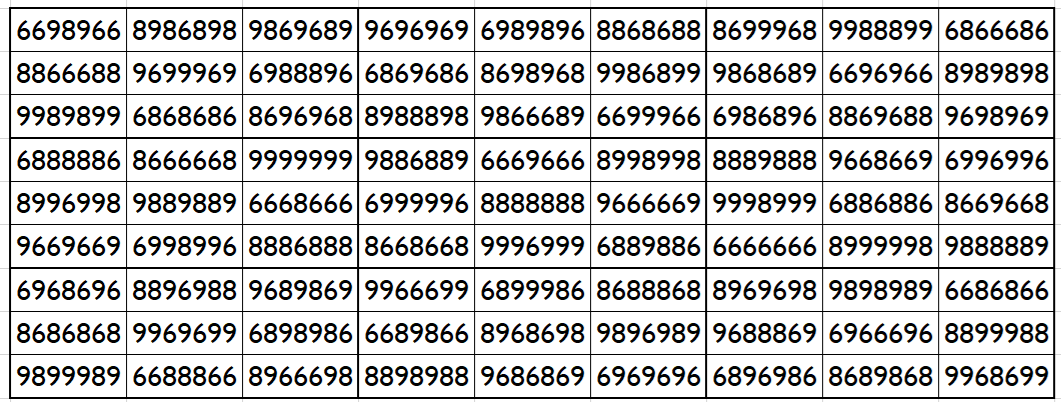
It is upside-down pandiagonal magic square of order 9 with 3-digits (6,8,9). The magic sum is given by S9×9(6,8,9):=76666659.
Example 31. The Digits (2,5,8)
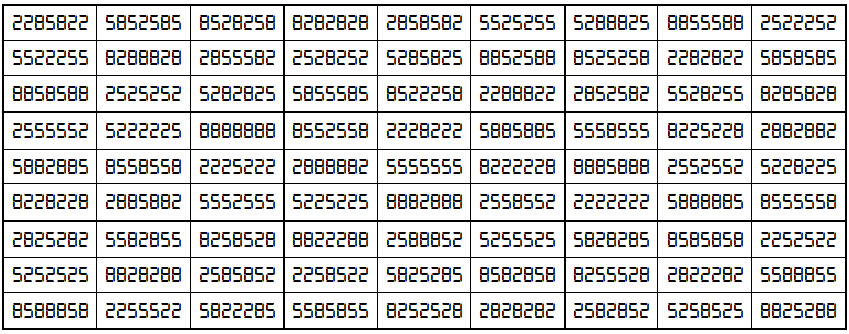
It is pandiagonal universal magic square of order 9 with 3-digits (0,2,5). The magic sum is given by S9×9(2,5,8):=49999995.
c) 8-Digits Cell Entries
Example 32. The Digits (1,8): Pandiagonal
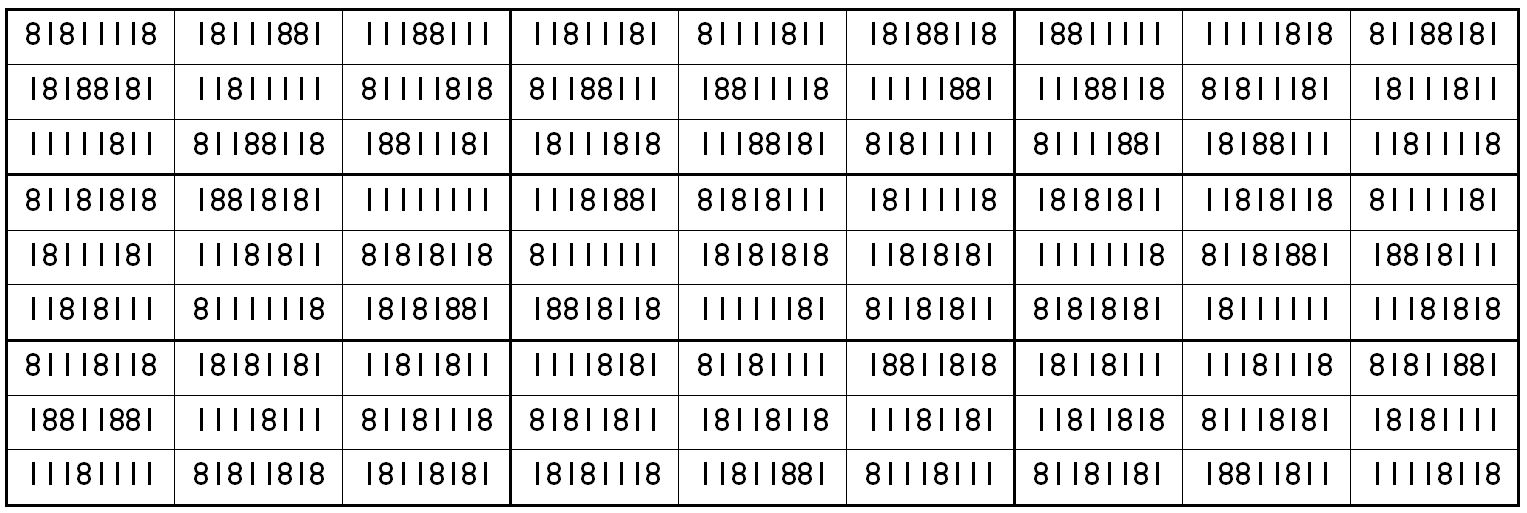
It is universal pandiagonal square with magic sum: S9×9(1,8):=333333330. Moreover, the bocks of order 3 are semi-magic square with equal semi-magic sum, i.e., S3×3 (1,8):=111111110.
Example 33. The Digits (2,5): Pandiagonal
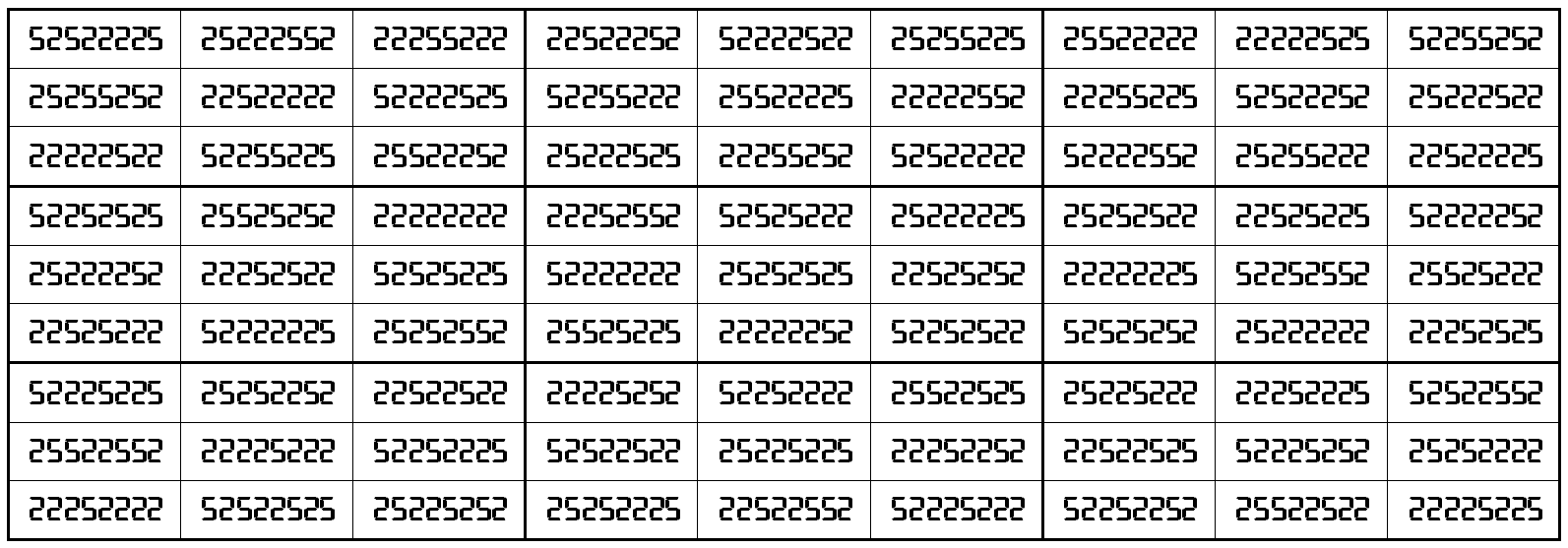
It is universal pandiagonal magic square with magic sums: S9×9(2,5):=299999997 and S9×9(2,5):=399999996. The magic sum S9×9(2,5):=399999996 refers to mirror looking version. The blocks of order 3 are semi-magic squares with equal semi-magic sums: S3×3(2,5):=99999999 and S3×3(2,5):=133333332.
Example 34. The Digits (6,9): Pandiagonal
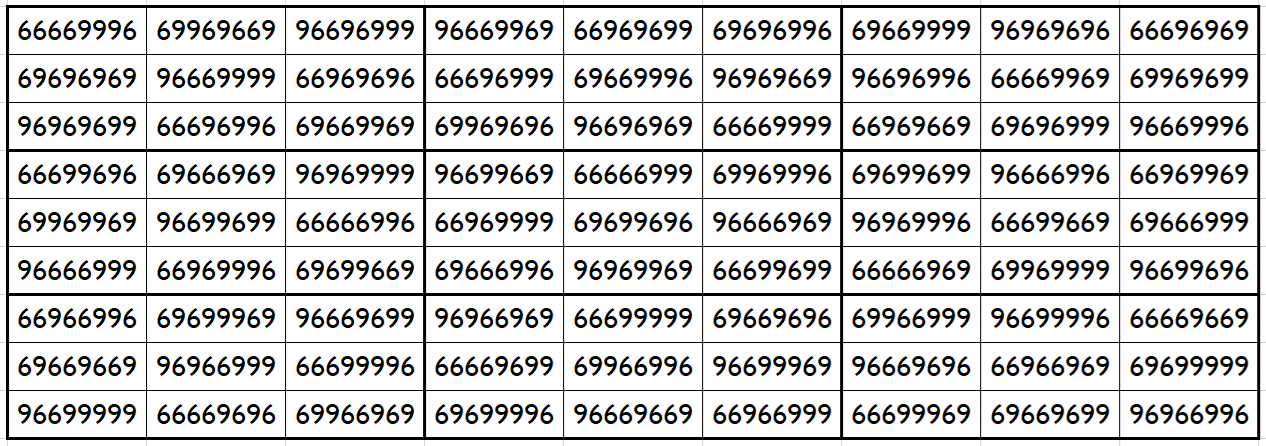
It is universal pandiagonal square with magic sum: S9×9(6,9):=700009992. Moreover, the bocks of order 3 are semi-magic squares with equal semi-magic sums, i.e., S3×3 (6,9):=233336664.
Magic Squares of Order 10
a) 4-Digits Cell Entries
Example 35. The Digits (1,6,9)
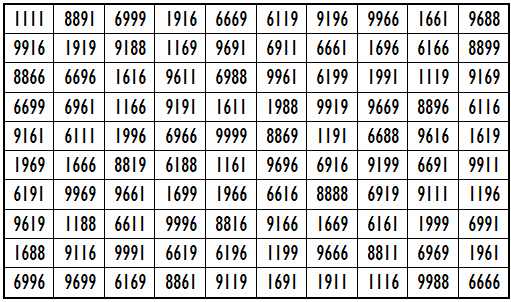
It is upside-down magic square of order 10 with 4-digits (1,6,8,9). The magic sum is given by S10×10(1,6,8,9):=62216.
Example 36. The Digits (0,2,5,8)
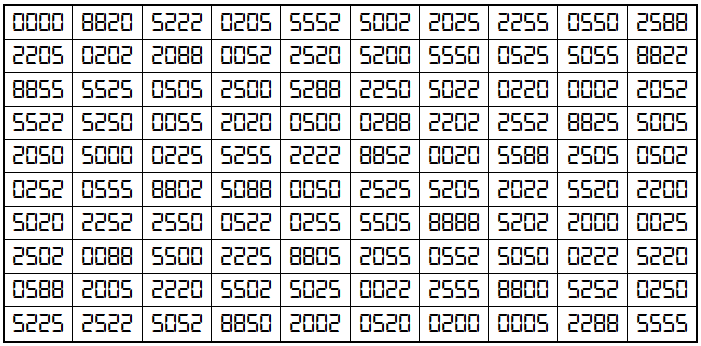
It is universal magic square of order 10 with 4-digits (0,2,5,8). The magic sum is given by S10×10(0,2,5,8):=32219.
b) 6-Digits Cell Entries
Example 37. The Digits (1,6,9)
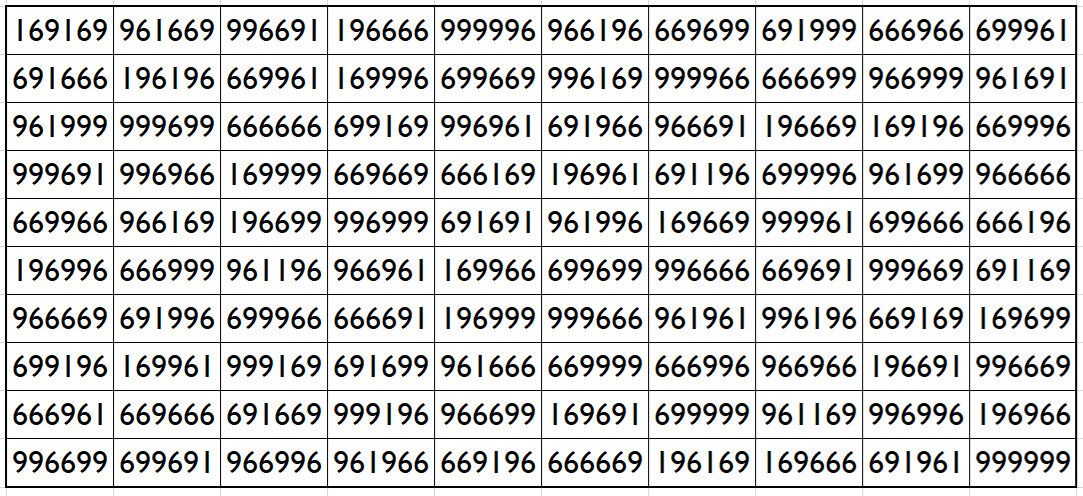
It is upside-down magic square of order 10 with 3-digits (1,6,9). The magic sum is given by S10×10(1,6,9):=7019012.
Example 38. The Digits (2,5,8)
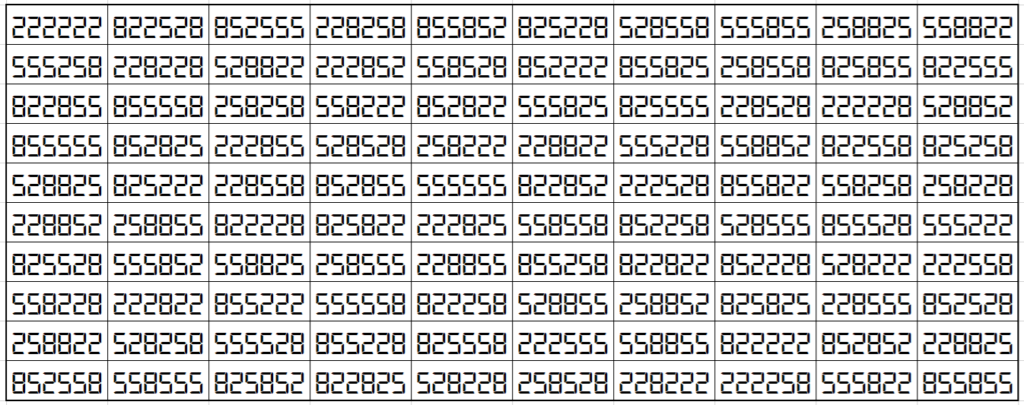
It is universal magic square of order 10 with 3-digits (2,5,8). The magic sum is given by S10×10(1,6,9):=5708703.
c) 8-Digits Cell Entries
Example 39. The Digits (1,8)

It is universal magic square of order 10 with magic sums S10×10(1,8):=422222218.
Example 40. The Digits (2,5)
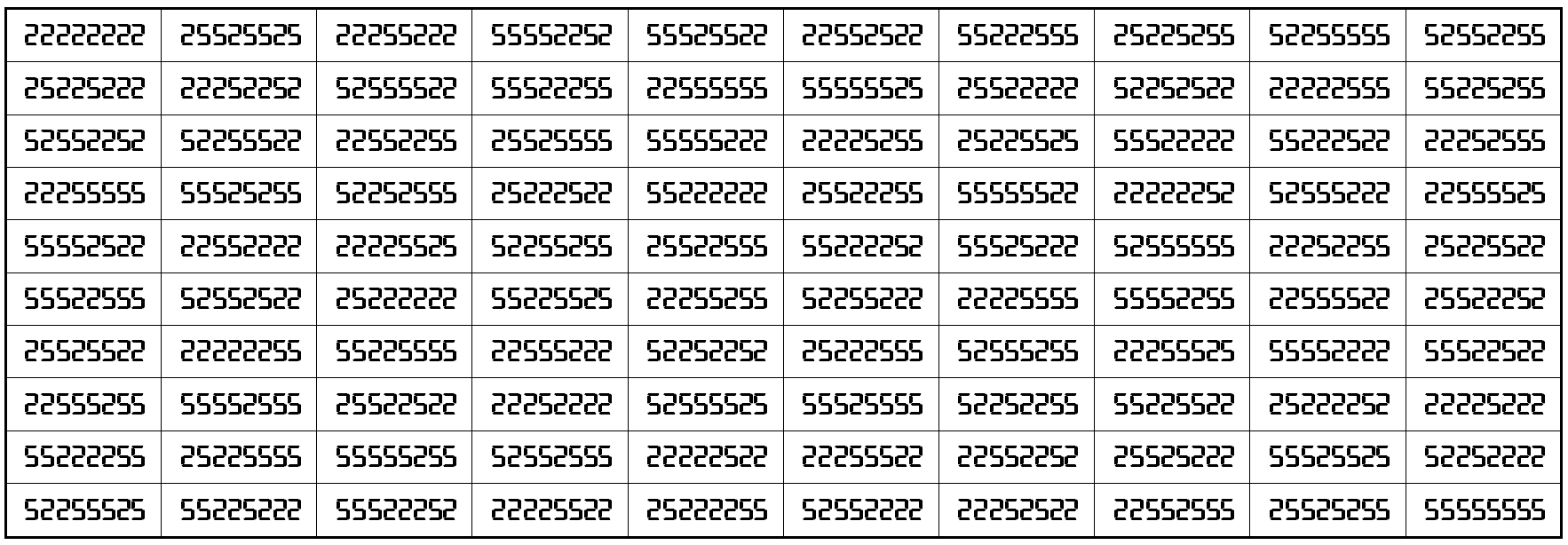
It is universal magic square of order 10 with magic sums S10×10(2,5):=388888885.
Example 41. The Digits (6,9)

It is universal magic square of order 10 with magic sums S10×10(6,9):=800660058.
References
- Inder J. Taneja, Universal and Upside-Down Magic Squares of Orders 3 to 6, Zenodo, November 05, 2024, pp. 1-61, https://doi.org/10.5281/zenodo.14041149
- Inder J. Taneja, Universal and Upside-Down Magic Squares of Orders 7 to 10, Zenodo, November 05, 2024, pp. 1-120, https://doi.org/10.5281/zenodo.14041164
- Inder J. Taneja, Universal and Upside-Down Magic Squares of Orders 11 to 15, Zenodo, November 05, 2024, pp. 1-141, https://doi.org/10.5281/zenodo.14041168
- Inder J. Taneja, Universal and Upside-Down Magic Squares of Order 16, Zenodo, October 16, 2024, pp. 1-28, https://doi.org/10.5281/zenodo.13942620
- Inder J. Taneja, Universal and Upside-Down Magic Squares of Order 20, Zenodo, October 20, 2024, pp. 1-56, https://doi.org/10.5281/zenodo.13958700.
- Inder J. Taneja, Universal and Upside-Down Magic Squares of Order 21, Zenodo, October 23, 2024, pp. 1-49, https://doi.org/10.5281/zenodo.13982859
- Inder J. Taneja, Universal and Upside-Down Magic Squares of Order 24, Zenodo, October 29, 2024, pp. 1-82, https://doi.org/10.5281/zenodo.14004788
- Inder J. Taneja, Universal and Upside-Down Magic and Bimagic Squares of Order 25, Zenodo, October 30, 2024, pp. 1-53, https://doi.org/10.5281/zenodo.14014851.
